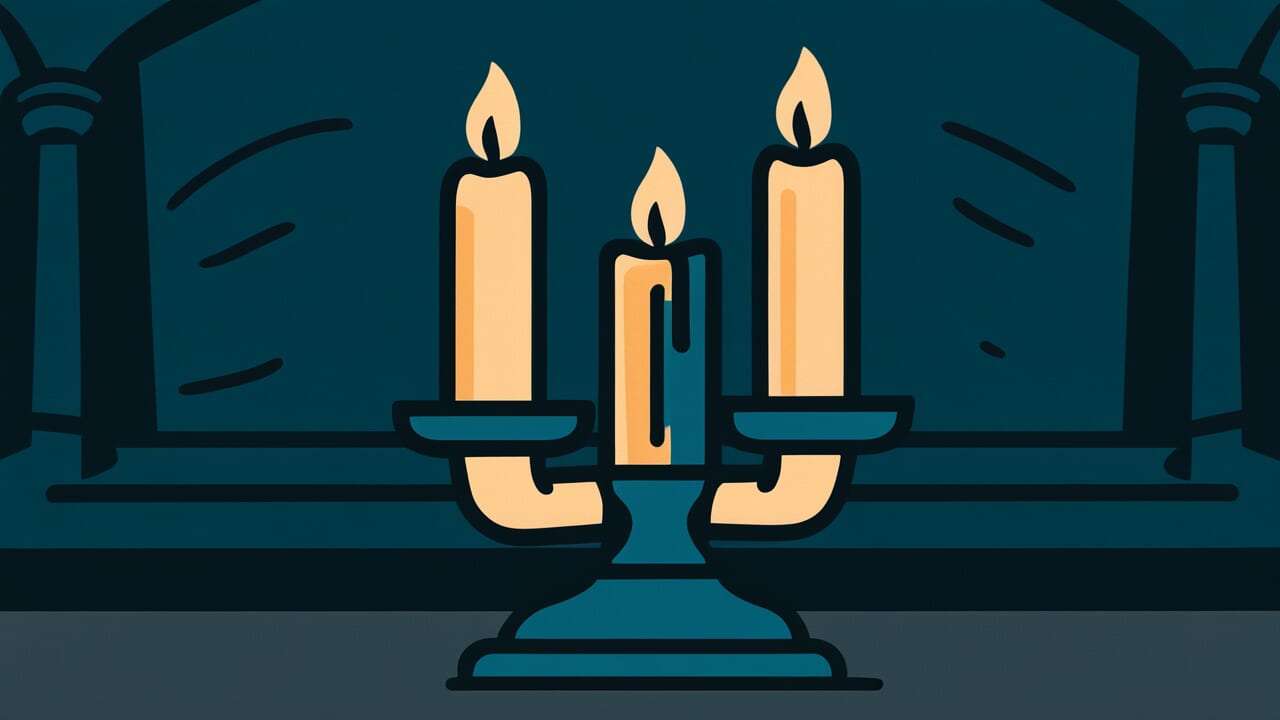How to Read “the darkest place is under the candlestick”
The darkest place is under the candlestick
[the DARK-est place is UN-der the CAN-dle-stick]
All words use standard pronunciation.
Meaning of “the darkest place is under the candlestick”
Simply put, this proverb means we often miss obvious problems that are right in front of us.
The saying paints a picture of an old-fashioned candle holder. The candle gives light to everything around it. But directly underneath the candlestick, there’s a shadow. This dark spot exists even though the light source sits right above it.
We use this wisdom when talking about blind spots in our daily lives. A teacher might miss a struggling student in their own classroom. A parent could overlook their child’s problems while helping other families. A business owner might ignore issues in their own company while giving advice to competitors.
What makes this insight so powerful is how it reveals human nature. We assume we see everything clearly in familiar places. Our confidence in what we know best can actually work against us. The closer something is to us, the easier it becomes to take it for granted or stop paying attention.
Origin and Etymology
The exact origin of this proverb is unknown, though it appears in various forms across different languages and time periods.
The saying comes from an era when candles provided the main source of indoor lighting. People lived with candlesticks every day and understood how they worked. Everyone knew that candles created shadows directly beneath them, even while lighting up the surrounding area. This made the image instantly recognizable and meaningful.
Proverbs like this one spread through everyday conversation and practical wisdom sharing. The concept appears in similar forms across many cultures, suggesting people everywhere noticed this pattern of overlooking the obvious. Over time, the literal meaning about candlesticks expanded to describe any situation where familiarity breeds blindness to problems.
Interesting Facts
The word “candlestick” comes from Old English, combining “candle” (from Latin “candela” meaning “to shine”) with “stick” (meaning a rod or support). This proverb demonstrates a common pattern in folk wisdom where physical observations about light and shadow become metaphors for human behavior and awareness.
Usage Examples
- Detective to partner: “We’ve been searching everywhere for the corrupt cop, but haven’t checked our own precinct thoroughly – the darkest place is under the candlestick.”
- IT manager to technician: “The server keeps getting hacked, but we never audited our own admin accounts – the darkest place is under the candlestick.”
Universal Wisdom
This proverb reveals a fundamental flaw in how human attention works. Our brains evolved to notice changes and threats in our environment, but they also developed shortcuts to save mental energy. Once something becomes familiar, we stop examining it closely. This efficiency helped our ancestors survive, but it creates blind spots in modern life.
The psychology behind this pattern runs deep. We develop mental maps of familiar territory and assume those maps stay accurate forever. A security expert might have an unsecured home network. A relationship counselor could miss warning signs in their own marriage. The very expertise that helps us see problems elsewhere can make us overconfident about areas we know well.
This blindness serves a protective function too. If we constantly questioned everything close to us, we’d be paralyzed by doubt. Trust and familiarity allow us to function efficiently in daily life. But this same trust becomes dangerous when it prevents us from seeing real problems. The candlestick creates its shadow not despite giving light, but because of it. Our strengths and our blind spots often spring from the same source.
When AI Hears This
Doctors often miss their own health problems while treating patients perfectly. Teachers struggle to help their own children with homework. IT experts can’t fix their home computers. When people become really good at something, they stop seeing basic mistakes. Their advanced skills create blind spots in simple areas. The expertise that makes them valuable also makes them overlook obvious solutions.
This happens because human brains take shortcuts with familiar territory. We stop questioning things we know well. Our minds assume we’ve already checked the basics thoroughly. But expertise changes how we see problems entirely. We jump to complex solutions and skip simple ones. The brain treats mastery as permission to ignore fundamentals.
This blindness might actually help humans in surprising ways. Skipping basics lets experts focus on harder challenges efficiently. If doctors examined every simple possibility first, they’d waste time. The darkness under the candle frees up mental energy. Sometimes missing obvious answers helps us find better ones. Human expertise works by strategic forgetting, not perfect remembering.
Lessons for Today
Living with this wisdom means developing the habit of stepping back from familiar situations. The challenge isn’t just seeing our blind spots, but remembering to look for them in the first place. Regular self-examination becomes essential, even when everything seems fine. Fresh perspectives from outsiders often reveal what we’ve stopped noticing.
In relationships and work, this awareness changes how we approach problems. Instead of immediately looking outward for causes, we can pause and examine what might be hiding in plain sight. Family members can ask each other honest questions about patterns they’ve stopped seeing. Teams can invite outside observers to point out obvious issues that insiders miss.
The goal isn’t to become paranoid about familiar territory, but to balance trust with healthy curiosity. Acknowledging our tendency toward blind spots makes us more humble and open to feedback. We can appreciate the light we bring to situations while staying alert to the shadows we might create. This wisdom works best when it makes us more thoughtful, not more anxious about everything we think we know.



Comments